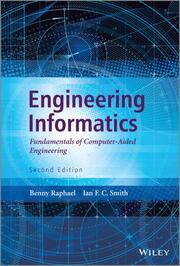-
Zusatztext
-
Computers are ubiquitous throughout all life-cycle stages of engineering, from conceptual design to manufacturing maintenance, repair and replacement. It is essential for all engineers to be aware of the knowledge behind computer-based tools and techniques they are likely to encounter. The computational technology, which allows engineers to carry out design, modelling, visualisation, manufacturing, construction and management of products and infrastructure is known as Computer-Aided Engineering (CAE). Engineering Informatics: Fundamentals of Computer-Aided Engineering, 2nd Edition provides the foundation knowledge of computing that is essential for all engineers. This knowledge is independent of hardware and software characteristics and thus, it is expected to remain valid throughout an engineering career. This Second Edition is enhanced with treatment of new areas such as network science and the computational complexity of distributed systems. Key features: * Provides extensive coverage of almost all aspects of Computer-Aided Engineering, outlining general concepts such as fundamental logic, definition of engineering tasks and computational complexity * Every chapter revised and expanded following more than ten years of experience teaching courses on the basis of the first edition * Covers numerous representation frameworks and reasoning strategies * Considers the benefits of increased computational power, parallel computing and cloud computing * Offers many practical engineering examples and exercises, with lecture notes available for many of the topics/chapters from the ASCE Technical Council on Computing and Information Technology, Global Centre of Excellence in Computing (www.asceglobalcenter.org), providing a valuable resource for lecturers. * Accompanied by a website hosting updates and solutions Engineering Informatics: Fundamentals of Computer-Aided Engineering, 2nd Edition provides essential knowledge on computing theory in engineering contexts for students, researchers and practising engineers.
-
-
Autorenportrait
- InhaltsangabeForeword to the First Edition xiii Preface to the First Edition xvii Preface to the Second Edition xxi 1 Fundamental Logic and the Definition of Engineering Tasks 1 1.1 Three Types of Inference 1 1.2 Engineering Tasks 3 1.3 A Model of Information and Tasks 5 1.4 Another Task Definition 8 1.5 The Five Orders of Ignorance 9 1.6 Summary 9 Exercises 10 References 10 2 Algorithms and Complexity 11 2.1 Algorithms and Execution Time of Programs 12 2.1.1 Program Execution Time versus Task Size 12 2.2 'Big Oh' Notation 14 2.2.1 Definition of the Big Oh Notation 15 2.2.2 Big Oh and Tightness of Bound 16 2.2.3 Classification of Functions 20 2.2.4 Examples 21 2.2.5 Tractability and Algorithm Optimality 30 2.3 Practical Methods for Determining the Complexity of Algorithms 30 2.4 P, NP and NP-Completeness 34 2.4.1 ZeroOne Integer Programming (ZOIP) Problem 35 2.4.2 Classes of NP-Complete Problems 36 2.5 Summary 37 Exercises 37 Reference 40 Further Reading 40 3 Data Structures 41 3.1 Introduction 41 3.2 Definitions 42 3.3 Derived Data Types 42 3.3.1 Examples of Derived Data Types 43 3.3.2 UserDefined Data Types 45 3.4 Abstract Data Types 46 3.4.1 Linked Lists 47 3.4.2 Graphs 50 3.4.3 Trees 52 3.4.4 Stacks 56 3.4.5 Queues 60 3.5 An Example: Conceptual Structural Design of Buildings 63 3.6 Network Science 70 3.6.1 Types of Networks 71 3.7 Hashing 73 3.8 Summary 74 Exercises 74 Further Reading 79 4 Object Representation and Reasoning 81 4.1 Introduction 81 4.2 Grouping Data and Methods 82 4.3 Definitions and Basic Concepts 83 4.3.1 Classes and Objects 83 4.3.2 ObjectOriented Programming (OOP) 84 4.3.3 Messages 84 4.4 Important Characteristics of Objects 84 4.4.1 Encapsulation of Data and Methods 84 4.4.2 Message-Passing Mechanism 85 4.4.3 Abstraction Hierarchy 86 4.4.4 Secondary Features of Object Representation 88 4.4.5 Decomposition versus Abstraction 89 4.5 Applications Outside Programming 90 4.5.1 Knowledge Representation 91 4.5.2 User Interfaces 91 4.5.3 OfftheShelf Components 91 4.5.4 Product Models 91 4.6 An Object-Oriented Design Methodology 93 4.6.1 Single versus Multiple Inheritance 93 4.6.2 Message-Passing Architecture 94 4.7 Summary 95 Exercises 95 References 101 Further Reading 101 5 Database Concepts 103 5.1 Introduction 103 5.2 Basic Concepts 104 5.2.1 Initial Definitions 104 5.2.2 Evolution of Types of Databases 104 5.2.3 The Three-Level Architecture 106 5.3 Relational Database Systems 106 5.3.1 The Relational Model 107 5.3.2 Limitations of Relational Databases 111 5.3.3 Accessing Data in Relational Databases 112 5.4 Relational Database Design 114 5.4.1 First Normal Form 114 5.4.2 Second Normal Form 115 5.4.3 Third Normal Form 118 5.4.4 BoyceCodd and Higher Normal Forms 119 5.4.5 Importance of Database Design 120 5.5 Transaction Processing 120 5.5.1 Definition of Transaction 121 5.5.2 Implementing Transactions 122 5.5.3 Properties of Transactions 124 5.6 Other Types of Database 124 5.6.1 ObjectOriented Databases 124 5.6.2 Geographical Databases 124 5.6.3 Multimedia Database Systems 125 5.6.4 Distributed Databases 125 5.7 Summary 126 Exercises 127 Transaction A 131 Transaction B 131 Reference 131 Further Reading 131 6 Computational Mechanics 133 6.1 Introduction 133 6.1.1 Challenges of Computational Mechanics 134 6.2 From Physical Principles to Practical Systems 135 6.3 Methods for Finding Solutions 137 6.3.1 Galerkin Method 137 6.3.2 Remarks 139 6.4 Issues in Computer-Aided Engineering 139 6.4.1 Accuracy 140 6.4.2 Speed 141 6.4.3 User Interaction 142 6.5 Summary 142 References 142 Further Reading 142 7 ConstraintBased Reasoning 143 7.1 Introduction 143 7.2 Terminology
Detailansicht
Engineering Informatics
Fundamentals of Computer-Aided Engineering
ISBN/EAN: 9781119953418
Umbreit-Nr.: 5267111
Sprache:
Englisch
Umfang: 356 S.
Format in cm:
Einband:
gebundenes Buch
Erschienen am 09.08.2013
Auflage: 2/2013


